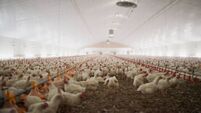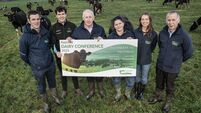Payment plans are at odds
They receive a much larger amount of direct payments from the EU for much the same reason — to support farming by stabilising income, ensuring the longer term viability of farms and making them less vulnerable to fluctuations in prices, thereby protecting the countryside through links with cross-compliance.
Unfortunately, both are the playthings of politicians, and the divergent paths the two payments are taking illustrate the fickleness of farmers’ political masters.
CAP reform proposes a more scientific approach to categorising disadvantaged areas — but a purely mathematical approach to direct payments, the desired end result of which seems to be dividing the number of hectares of farmland in the EU into the sum available, and giving everyone the same amount per hectare.
In Ireland, that would (very) approximately, and in average terms, take more than €5,000 each from farmers in the more fertile and productive counties, and award nearly €4,000 extra to each farmer in the more disadvantaged counties.
The opposite approach is being taken with disadvantaged-area payments. Instead of the established designation that makes most areas of Ireland west of a certain line disadvantaged, the trend is towards using the depth of the soil, moisture-retention qualities, and climate and stocking rate, on a parish-by-parish basis, to scientifically estimate disadvantage and qualification for payments.
This assessment is going on in Ireland, and will not be completed until the end of 2015.
Agriculture Minister Simon Coveney anticipates this will give rise to significant political problems, if it breaks up areas now considered disadvantaged into pockets that may or may not be disadvantaged.
But they will pale into insignificance beside the political problems of the direct-payments national flat-rate model proposed in CAP reform, which would result in very large money transfers between Irish farmers.
There would also be serious political consequences from the inevitable dislocation of Irish food production caused by taking €5,000 each from 57,000 farmers and awarding €4,000 extra to about 76,000 farmers.
No-one can predict how that would affect food production (the research team at Rabobank says CAP reform proposals would move prime beef production not just from Ireland, but from north-western Europe, to southern and eastern Europe).
In Ireland, it’s not just beef production that would be affected — although this major farm enterprise is largely bankrolled by EU direct payments.
It’s in the south and east that many of the farmers who could, on average, lose €5,000 are situated. The south and east produce more than 80% of national milk output, more than 60% of national cattle output, and more than 80% of national cereal output.
Farmers in the south and east get 61% of their agricultural income in the form of subsidies, including direct payments.
Farmers in the border, midland and western regions (Cavan, Donegal, Leitrim, Louth, Monaghan, Sligo, Laois, Longford, Offaly, Westmeath, Galway, Mayo and Roscommon), get 110.4% of agricultural income in the form of subsidies — in other words, they lose money at farming, it is completely subsidised.
Can they increase production if they get €4,000 extra? That is an important question for the economy, ahead of the proposed arbitrary redistribution of about €350m per year.
Just how arbitrary it is can be seen from the list of countries trying to avoid it.
Member states as diverse as Italy, Spain, Portugal, Luxembourg (the richest member state) and Denmark support Ireland’s proposal to water down redistribution with an external, convergence model. In Ireland, this model would see 65,000 farmers gaining 29.1% on average; 55,916 losing 8.8% on average; and 8,943 farmers unaffected.
Why did politicians in Brussels come up with such divergent plans for direct payments and for disadvantaged payments?
What agendas are behind the proposals? How could they be applied equally in 27 countries from the Netherlands to Denmark, which, respectively, get 15% and 70% of farm income from direct payments?
Those are the political riddles that Agriculture Minister Simon Coveney and his negotiating team must solve.









